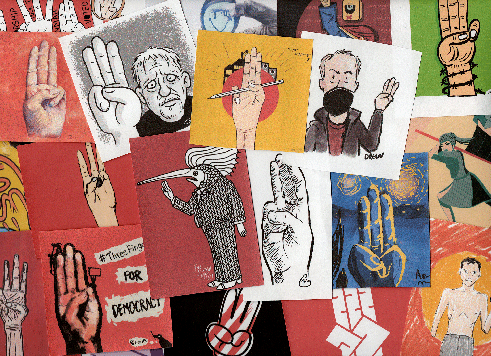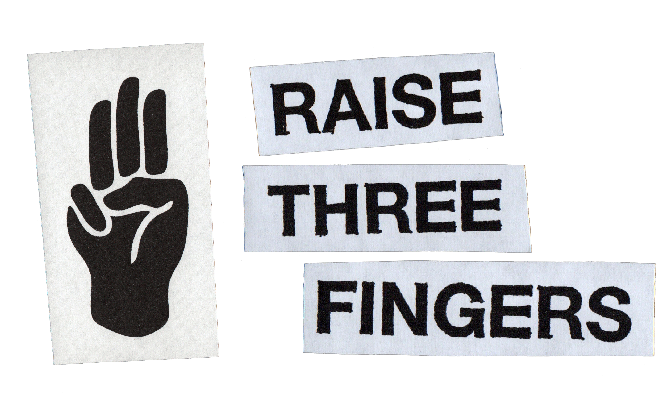Arts Help is officially partnering with the Raise Three Fingers campaign to support artists and creative activists that are raising awareness for the unfolding humanitarian crisis in Myanmar. After the military coup on February 1st, 2021, countless human rights violations and violent atrocities have been carried out by the regime through Myanmar, and Arts Help stands in solidarity with those fighting back.

The three finger salute of Raise Three Fingers is an international call for justice, freedom, and democracy for the people of Myanmar. The powerful symbol has passed through the hands of artists around the world, transforming and adapting the symbol to call upon the global community. Raise Three Fingers has already helped curate over 900 works from artists supporting the cause, and Managing Editor Hannah Chew interviewed three of these impactful artists for more information on their work and the movement.
Maw Khin Thit
Tell me about your work and personal background.
I’m a documentary filmmaker. I have been a part of the Myanmar independent film community for the past 7 years producing short films and documentaries. I have an undergraduate degree from the United States, and I came back to Myanmar when it was transitioning into a semi-democracy.
How did you get involved with film? Why is it your medium of choice for this project?
We started Latt Thone Chaung as a way to contribute to the protest movement. The reason we focused on video content is because we've always done video in the past. We do films, documentaries and other film media. Film is not something new I just picked up, it’s my job. We're trying to fight back in the way we know how to fight.
We went to a couple of protests to see the atmosphere and I realized that my role in this revolution is to produce content. I would be useless in the frontline holding a shield with my bad knee and low stamina.
With film as the main medium, I can easily add English subtitles to videos coming out of Myanmar to be accessible to an international audience. I can also create content for Myanmar audiences to mobilize and give a morale boost. I can do counter-propaganda work, showing how many soldiers and police are defecting, how the Civil Disobedience Movement is going, and what’s happening at the front lines of protest.
Tell me about your work in relation to Raise Three Fingers and Myanmar activism?
Raise Three Fingers was born out of a collaboration with Art for Freedom MM, the Professional Cartoonists’ Organisation (UK), and other artists from Myanmar. In a time when the junta, is using violence and terror, we wanted to use art as a way to fight back.
Our aim is to use the power of the collective to raise awareness for the democracy movement in Myanmar. As artists and creatives, we all have the power to influence through our art. By building this global digital canvas of three-finger salute artwork, we’re keeping the pressure on and showing the people of Myanmar that the world is with them.
What role does art play in the activism and justice movement?
Even from the early days, we saw protest art blossoming on different social media platforms. Some of these artists weren’t political artists but were moved to get involved in making content because we all want to get involved. It’s like all these artists were pouring their hearts out into this movement.
At a very basic level, art plays a very practical role. It gets people energized, it makes people emotional, and it gets people to organise and get things done. For example, the International Women’s Day Htamein protests, the Flower Strike, the Easter Egg strike, and all these movements popping up day-to-day originatesd largely from artists creating posters and graphics and social media users spreading the word online.
Art helps to frame the direction of the protest movement. People can just write up a text explaining what they want to do but if it comes with a picture and a visual or a video, then it gets people moving. It’s a really practical way to mobilise people. Art can also create hope and resilience. It takes people to another level and can help uplift the mood of the people.
How do you perceive the power of the three fingers symbol?
It’s a show of unity, to say we're in this together, and a show of defiance and that we don't accept this coup and we will do whatever we can to overturn it.
What advice would you give to young artists and activists looking to use their art to make an impact?
I believe art – in all its forms – can give strength to people. For me, it’s poetry. “The war, people said, had revived their interest in poetry,” a quote from Virginia Woolf’s To the Lighthouse. It has always stayed with me. There are times when nothing else makes sense and poetry comes along to put things into perspective. That’s what art can do. It’s important to keep creating because you can’t handcuff ideas. You can’t kill art with bullets.
Being an artist and a creative is what the authoritarian regime doesn’t want you to do. So, the act of creating art itself is a form of resistance.
Ohn Mar Win
Tell me about your work and personal background.
I’m an illustrator, designer, teacher and author based in Hertfordshire, England. As a child I was described as being “far too curious,” often disappearing to make up imaginary adventures and climb trees. I moved to the UK when I was five, and not knowing the language very well at first, I used drawings to communicate with my teachers, helping me to become incredibly visually creative. These days I’m best known for my fruit and vegetables illustrations, which have appeared on countless branding and packaging projects for clients all over the world.



Why have you chosen to paint Three Fingers every day? What does this repetition mean to you and the movement?
I started painting three finger salutes after recovering from tonsillitis when it was difficult to speak and to communicate. It was like a lightbulb moment. The Civil Disobedience Movement in Myanmar was gathering pace and it just felt different. I’m old enough to remember similar pro-democracy situations in 1988 and 2007, before they were suppressed by the military. And I also recall how quickly the media tends to move on to the next new story, while those in Myanmar continue to deal with brutality and hardship.
I use my sketches as a tool to communicate as I’m quite introverted. I’m also known for very lengthy daily sketchbook projects I’ve completed in the past that reflect my persistence and need to explore. The three finger salutes are simply an extension of that and serve as a humble acknowledgment to those who continue protesting, risking their own lives.
I try to post a three-finger salute on IG stories with current info on the situation in Burma, my feelings about events and if I’ve heard from my family there. I post the three-finger salute art first before my other work in progress, to remind my followers to PLEASE don’t forget the suffering and unfolding situation in Myanmar, and perhaps asking them to sign a petition.
Each salute isn’t dreadfully remarkable on its own but viewed together as a whole after more than 60 days is quite impressive. It echoes all the little ways that people in Burma are contributing to the movement. They all add up to a tremendous joint effort that cannot be underestimated.
In your opinion, what is the best way to raise awareness for the movement?
I honestly don’t know. There’s quite a lot of indifference and inertia, because I think the situation in Myanmar – with beatings, killings and torture – is beyond the comprehension of most people outside the country. I have to believe that reminding folks everyday with snippets of information will over time have a cumulative effect. And such a tiny action on my part can be added to the collective movement which will keep building up momentum over time.
How can artists around the world contribute to the Raise Three Fingers effort and support Myanmar?
Art can be such a powerful tool on many levels, and we can all play our part to keep up awareness of Myanmar's fight for a true and lasting democracy. I see it as a collective practice that links us all because we can use our freedoms and privilege to be present.
Artists around the world can draw their own versions of the three-finger salute, whether on the back of an envelope or painted on a giant canvas, spread the same mutual solidarity and message.
What advice would you give to young artists and activists looking to use their art to make an impact?
We are at a crucial juncture in terms of climate change, animal extinction, and fighting for our liberties in many parts of the world. We all want a brighter future for our children and the next generations. Art is a wonderful way to express ourselves and help us grow and understand the world around us. It’s a special type of communication that doesn’t need language, yet can deliver very powerful messages, empower and inform. Always create art from the heart and send it out into the world with love and it will do its work.
Nobel Aung
Tell me about your work and personal background.
I am a Comic Artist and Animator from Yangon, Myanmar. I run an animation studio with 30 members that has closed since the coup started on February 1st, 2021.
What journey brought you to help create Art for Freedom?
Since day one of the coup, local artists started creating and spreading artwork through the Internet. One of my colleagues and I started “Art for Freedom,” a private Facebook group collecting these artworks and sharing it with people for using it in protests.
We set some ground rules that all artworks uploaded in the group must be royalty-free and support the movement against the military coup. Many artists and non-artists alike joined, and the page became quite a success, becoming the main source for designs and images for protests on the ground. Our purpose for creating this group was to arm protestors with art. Not with guns.
What challenges have you faced on the way during your amazing work? What has been the most inspiring point of your journey?
The lack of safety and lack of Internet connection have been our biggest challenges. We have been threatened, arrested, and beaten by the military. They don’t like us creating art against the coup.
The most inspiring thing has been the unity of people. We all have the same objective. This was apparent since the very first night of the coup. People continue to bang their pots and pans every night at 8 pm to make noise, every day even until now. We are not scared of guns anymore, but the military is scared of the noise we make. We give courage and inspiration to each other.
What role does art play in the activism and justice movement?
All kinds of art play a very important role in peaceful protest. Painting, singing, sculpting, dancing, etc. Art screams louder. Art presents the voice of people. Art creates trends that unite people on what to do next.
What advice would you give to young artists and activists looking to use their art to make an impact?
If you are a local artist, please be alert with the changing situation and the different strategies. Keep your eyes open. People in Myanmar do one or two big protests every week – keep yourself informed.
Art always has a meaning. Stay safe.

For more information on Raise Three Fingers and how to support people in Myanmar, visit https://www.threefingers.org/
